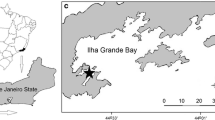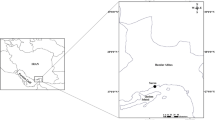Abstract
Several emerging therapeutic applications of agar and its derivatives make it one of the sought-after hydrocolloids, commanding the highest price in global markets. In India farming of local agarophyte species is commercially successful supporting domestic demand coupled with natural harvesting. Several investigations have addressed issues with cultivar development and biological attributes, but technology improvements in farming are seldom attempted. The aim of the present investigation was to study the effect of tube-net diameter on growth and agar obtained from the industrially important red alga Gracilaria dura. CFD modelling also was used to predict the water velocity distribution in tube-nets. Daily growth rate (DGR) in 10-cm diameter (10 cm-DN) tube-nets was 2.5 ± 0.15% day−1 and 3.39 ± 0.10% day−1 in 8 cm diameter (8 cm-DN) tube-nets. In the 8 cm-DN, the biomass outside the tube was 51.83 ± 2.69% higher than biomass inside the tube and in 10 cm-DN, biomass inside the tube was 53.53 ± 2.16% higher. Two-dimensional CFD simulations confirmed that the velocity distribution in and around the tube-net was higher in 8 cm-DN than 10 cm-DN leading to better growth in the former. The agar yield after tissue segregation showed a 14.06% increase for the biomass harvested from inside the tube than outside in the 10 cm-DN, while it was 17.75% in the 8 cm-DN. Similarly, agar gel strength recorded a 38.47% increase in the biomass harvested from outside the tube compared with the inside biomass in the 10 cm-DN, and the increase was 11.96% in the 8 cm-DN. Further studies using various tube-net diameters are necessary to select the optimal diameter for undertaking commercial farming of G. dura in the open sea.






Similar content being viewed by others
References
Ashok KS, Harikrishna P, Gobala Krishnan M, Saminathan KR, Monisha N, Malarvizhi J, Veeragurunathan V, Mantri VA, Rajasankar J (2016) Does orientation of raft helps in augmenting yield during lean period?: a case study of Gracilaria edulis cultivation in open sea by vertical raft alignment along the southeastern coast of India. Aquac Eng 74:186–197
Brugere C, Msuya F, Jiddawi N, Nyonje B, Maly R (2020) Can innovation empower? Reflections on introducing tubular nets to women seaweed farmers in Zanzibar. Gend Technol Dev 24:89–109
Buschmann AH, Westermeier R, Retamales C (1995) Cultivation of Gracilaria in the sea-bottom in southern Chile: a review. J Appl Phycol 7:291–301
Buschmann AH, Correa JA, Westermeier R, Hernández-González MC, Norambuena R (2001) Red algal farming in Chile: a review. Aquaculture 194:203–220
Carter AR, Anderson RJ (1986) Seasonal growth and agar contents in Gelidium pristoides (Gelidiales, Rhodophyta) from Port Alfred, South Africa. Bot Mar 29:117–123
Craigie JS, Wen ZC (1984) Effects of temperature and tissue age on gel strength and composition of agar from Gracilaria tikvahiae (Rhodophyceae). Can J Bot 62:1665–1670
Critchley AT (1993) Gracilaria (Rhodophyta, Gracilariales): an economically important agarophyte. In: Ohno M, Critchley AT (eds) Seaweed cultivation and marine ranching. Kanagawa International Fisheries Training Center and JICA, Yokosuka, Japan, pp 89–112
Di Rienzo JA, Casanoves F, Balzarini MG, Gonzalez L, Tablada M, Robledo CW (2018) InfoStat version. Centro de Transferencia InfoStat, Facultad de Ciencias Agropecuarias, Universidad Nacional de Córdoba, Argentina. http://www.infostat.com.ar
FAO (2018) The global status of seaweed production, trade and utilisation. Goldfish Research Programme Volume 124. FAO, Rome. 120 pp
FAO (2020) The State of World Fisheries and Aquaculture 2020. Sustainability in action. Rome. https://doi.org/10.4060/ca9229en
Friedlander M, van Rijn J (2018) Ammonia and CO2 enrichment of a Gracilaria cultivation pond through bio-filtration of organic waste. Aquaculture 482:45–48
Ganesan M, Thiruppathi S, Eswaran K, Reddy CRK, Jha B (2009) Cultivation of Gelidiella acerosa in the open sea on the southeastern coast of India. Mar Ecol Prog Ser 382:49–57
Ganesan M, Sahu N, Eswaran K (2011a) Raft culture of Gracilaria edulis in open sea along the south-eastern coast of India. Aquaculture 321:145–151
Ganesan M, Thiruppathi S, Eswaran K, Reddy CRK, Jha B (2011b) Development of improved method of cultivation to obtain high biomass of the red alga Gelidiella acerosa (Gelidiales, Rhodophyta) in the open sea. Biomass Bioenergy 35:2729–2736
Ganesan M, Reddy CRK, Jha B (2015) Impact of cultivation on growth rate and agar content of Gelidiella acerosa (Gelidiales, Rhodophyta). Algal Res 12:398–404
Gerard VA, Mann KH (1979) Growth and production of Laminaria longicruris (Phaeophyta) populations exposed to different intensities of water movement. J Phycol 15:33–41
Glenn EP, Moore D, Brown JJ, Tanner R, Fitzsimmons K, Akutigawa M, Napolean S (1998) A sustainable culture system for Gracilaria parvispora (Rhodophyta) using sporelings, reef growout and floating cages in Hawaii. Aquaculture 165:221–232
Góes HG, Reis RP (2011) An initial comparison of tubular netting versus tie-tie methods of cultivation for Kappaphycus alvarezii (Rhodophyta, Solieriaceae) on the south coast of Rio de Janeiro State, Brazil. J Appl Phycol 23:607–613
Hadley S, Wild-Allen K, Johnson C, Macleod C (2015) Modeling macroalgae growth and nutrient dynamics for integrated multi-trophic aquaculture. J Appl Phycol 27:901–916
Hurd CL (2000) Water motion, marine macroalgal physiology, and production. J Phycol 36:453–472
Hurtado-Ponce AQ (1994) Agar production from Gracilariopsis heteroclada (Gracilariales, Rhodophyta) grown at different salinity levels. Bot Mar 37:97–100
Hurtado-Ponce AQ, Samonte GPB, Luhan Ma R, Guanzon N (1992) Gracilaria (Rhodophyta) farming in Panay, Western Visayas, Philippines. Aquaculture 105:233–240
Jayasankar R, Varghese S (2002) Cultivation of marine red alga Gracilaria edulis (Gigartinales, Rhodophyta) from spores. Ind J Mar Sci 31:75–77
Kavale MG, Veeragurunathan V, Mantri VA (2018) Handbook on Gracilaria dura. Central Salt and Marine Chemicals Research Institute Publication. 46 p
Kavale MG, Yadav A, Mantri VA (2021) Initial comparison between monoline and tube net method of farming in red agarophyte Gracilaria dura: Evidence from hydrodynamic CFD simulations. Aquaculture 536:736485
Kerrison PD, Stanley MS, Black KD, Hughes AD (2017) Assessing the suitability of twelve polymer substrates for the cultivation of macroalgae Laminaria digitata and Saccharina latissimi (Laminariales). Algal Res 22:127–134
Kerrison PD, Stanley MS, Hughes AD (2018) Textile substrate seeding of Saccharina latissima sporophytes using a binder: an effective method for the aquaculture of kelp. Algal Res 33:352–357
Kerrison PD, Twigg G, Stanley MS, De Smet D, Buyle G, Pina AM, Hughes AD (2019) Twine selection is essential for successful hatchery cultivation of Saccharina latissima, seeded with either meiospores or juvenile sporophytes. J Appl Phycol 31:3051–3060
Kerrison PD, Innes M, Macleod A, McCormick E, Elbourne PD, Stanley MS, Hughes AD, Kelly MS (2020) Comparing the effectiveness of twine- and binder-seeding in the Laminariales species Alaria esculenta and Saccharina latissima. J Appl Phycol 32:2173–2181
Kregting L, Blight AJ, Bera BE, Savidge G (2016) The influence of water motion on the growth rate of the kelp Laminaria digitata. J Exp Mar Biol Ecol 448:337–345
Lee WK, Lim YY, Leow ATC, Namasivayam P, Abdullah JO, Ho CL (2017) Biosynthesis of agar in red seaweeds: a review. Carbohydr Polym 164:23–30
Mantri VA, Thakur MC, Kumar M, Reddy CRK, Jha B (2009) The carpospores culture of industrially important red alga Gracilaria dura (Gracilariales, Rhodophyta). Aquaculture 297:85–90
Mantri VA, Ashok KS, Saminathan KR, Rajasankar J, Harikrishna P (2015) Concept of triangular raft design: Achieving higher yield in Gracilaria edulis. Aquac Eng. 69:1–6
Mantri VA, Ashok KS, Mohammad Musamil T, Gobalakrishnan M, Saminathan KR, Behera DP, Ghosh PK (2017) Tube-net farming and device for efficient tissue segregation for industrially important agarophyte Gracilaria edulis (Rhodophyta). Aquac Eng 77:132–135
Mantri VA, Ganesan M, Gupta V, Krishnan P, Siddhanta AK (2019) An overview on agarophyte trade in India and need for policy interventions. J Appl Phycol 31:3011–3023
Mantri VA, Shah Y, Thiruppathi S (2020) Feasibility of farming the agarose-yielding red alga Gracilaria dura using tube-net cultivation in the open sea along the Gujarat coast of NW India. Appl Phycol 1:12–19
Marinho-Soriano E, Bourret E, De Casabianca ML, Maury L (1999) Agar from the reproductive and vegetative stages of Gracilaria bursa-pastoris. Bioresour Technol 67:1–5
Meena R, Prasad K, Ramavat BK, Ghosh PK, Eswaran K, Thiruppathi S, Mantri VA, Subbarao PV, Siddhanta AK (2007) Preparation, characterization and benchmarking of agarose from Gracilaria dura of Indian waters. Carbohydr Polym 69:179–188
Mendoza WG, Ganzon-Fortes ET, Villanueva RD, Romero JB, Montano MNE (2006) Tissue age as a factor affecting carrageenan quantity and quality in farmed Kappaphycus striatum (Schmitz) Doty ex Silva. Bot Mar 49:57–64
Nogueira MCF, Henriques MB (2020) Large-scale versus family-sized system production: economic feasibility of cultivating Kappaphycus alvarezii along the southeastern coast of Brazil. J Appl Phycol 32:1893–1905
Padhi S, Swain PK, Behura SK, Baidya S, Behera SK, Panigrahy MR (2011) Cultivation of Gracilaria verrucosa (Huds) Papenfuss in Chilka Lake for livelihood generation in coastal areas of Orissa State. J Appl Phycol 23:51–155
Porse H, Rudolph B (2017) The seaweed hydrocolloid industry: 2016 updates, requirements, and outlook. J Appl Phycol 29:2187–2200
Raju PV, Thomas PC (1971) Experimental cultivation of Gracilaria edulis (Gmel.) Silva. Bot Mar 14:71–75
Rosman JH, Monismith SG, Denny MW, Koseff JR (2010) Currents and turbulence within a kelp forest (Macrocystis pyrifera): insights from a dynamically scaled laboratory model. Limnol. Oceanogr. 55:1145–1158
Santelices B, Doty MS (1989) A review of Gracilaria farming. Aquaculture. 78:95–133
Subbaramaiah K, Thomas PC (1990) Raft cultivation of Gracilaria edulis (Gmel.) Silva. Proc Ind Acad Sci (Plant Sci) 100:123–127
Veeragurunathan V, Eswaran K, Saminathan K, Mantri VA, Malarvizhi J, Ajay G, Jha B (2015) Feasibility of Gracilaria dura cultivation in the open sea on the south eastern coast of India. Aquaculture. 438:68–74
Veeragurunathan V, Prasad K, Malarvizhi J, Singh N, Meena R, Mantri VA (2019) Gracilaria debilis cultivation, agar characterization and economics: bringing new species in the ambit of commercial farming in India. J Appl Phycol 31:2609–2621
Vettori D, Nikora V (2019) Flow-seaweed interactions of Saccharina latissima at a blade scale: turbulence, drag force, and blade dynamics. Aquat Sci 18:61
Yang YF, Fei XG, Song JM, Hu HY, Wang GC, Chung IK (2006) Growth of Gracilaria lemaneiformis under different cultivation conditions and its effects on nutrient removal in Chinese coastal waters. Aquaculture 254:248–255
Zertuche-Gonzalez JA, Garcia-Lepe G, Pacheco-Ruiz I, Chee A, Gendrop V, Guzman JM (2001) Open water Chondrus cripus Stackhouse cultivation. J Appl Phycol 13:249–253
Acknowledgements
We thank Director CSIR-CSMCRI for its facilities. The comments from two anonymous reviewers and the editor have greatly improved the contents. This manuscript has PRIS registration no. 73/2020.
Funding
This work was financially supported by the Council for Scientific and Industrial Research, New Delhi.
Author information
Authors and Affiliations
Corresponding authors
Additional information
Publisher’s note
Springer Nature remains neutral with regard to jurisdictional claims in published maps and institutional affiliations.
Supplementary information
ESM 1
(DOCX 5750 kb)
Rights and permissions
About this article
Cite this article
Shah, Y., Yadav, A., Kumar, M.A. et al. ‘Proof of concept’ of how tube-net diameter affects growth and agar content in industrially important farmed red seaweed Gracilaria dura. J Appl Phycol 33, 2349–2358 (2021). https://doi.org/10.1007/s10811-021-02443-x
Received:
Revised:
Accepted:
Published:
Issue Date:
DOI: https://doi.org/10.1007/s10811-021-02443-x




